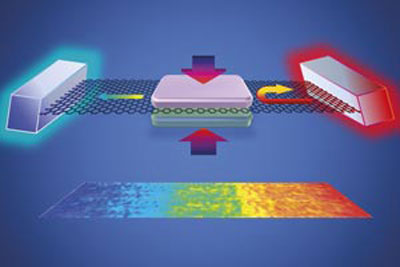| Posted: Jun 15, 2016 |
Graphene-based thermal modulators
(Nanowerk News) One of the biggest problems in designing electronic components is getting rid of excess heat. Now, A*STAR researchers have found a simple way to vary the heat flow in graphene, a breakthrough that will improve attempts to put superfluous heat in electronics to good use (Nano Research, "Graphene-based thermal modulators").
|
|
Graphene, a two-dimensional material consisting of a one-atom thick carbon sheet, has an extraordinarily high thermal conductivity. Liu Xiangjun from the A*STAR Institute of High Performance Computing and co-workers have developed a way to decrease graphene’s thermal conductivity, enabling excess heat to be diverted toward components that can dissipate it or even turn it into electricity.
|
 |
| Clamps applied to graphene reduce the heat flow from a hot component, at right, toward a cooler region at left, by scattering phonons. (Image: A*STAR Institute of High Performance Computing)
|
|
The team’s simulations showed that clamping graphene between two other graphene sheets will, with only moderate pressure, reduce thermal conductivity by a third. Adding more clamps and varying the pressure allows the heat flow to be tuned, creating a ‘thermal modulator’, similar to electrical components such as variable resistors that control the flow of electricity.
|
|
Another advantage is that clamping does no permanent damage to the graphene. Popular approaches to changing graphene’s thermal properties include doping or introducing defects to its structure, which change the material permanently. The A*STAR team’s approach, however, offers a considerable gain. “It does not change the crystal structure and is fully reversible — if the pressure is removed, the graphene returns to its pristine state,” explains Liu.
|
|
The team’s design was developed using molecular dynamics to simulate the movement of phonons, the thermal equivalent of electromagnetism’s photons. They discovered that phonons were being scattered because the mechanical force was shifting phonon energy levels and causing a mismatch with energy levels in the unclamped graphene.
|
|
Liu was especially surprised to find that the boundaries of the clamped area had the largest energy level shift and so dominated the scattering, and the effect was less significant in the center of the clamps. “We did not expect that,” Liu said. “We’ve revealed some fundamental principles governing thermal transport.”
|
|
To create more boundaries the team changed their simulation from a single clamped area to multiple smaller areas and found that the thermal conductivity did indeed drop dramatically.
|
|
Liu cautions that the effect relies on graphene’s two-dimensional nature and will not work in bulk materials. “People are more and more interested in building three-dimensional integrated circuits which need two-dimensional materials. I think our approach can be a part of these systems,” he said.
|

